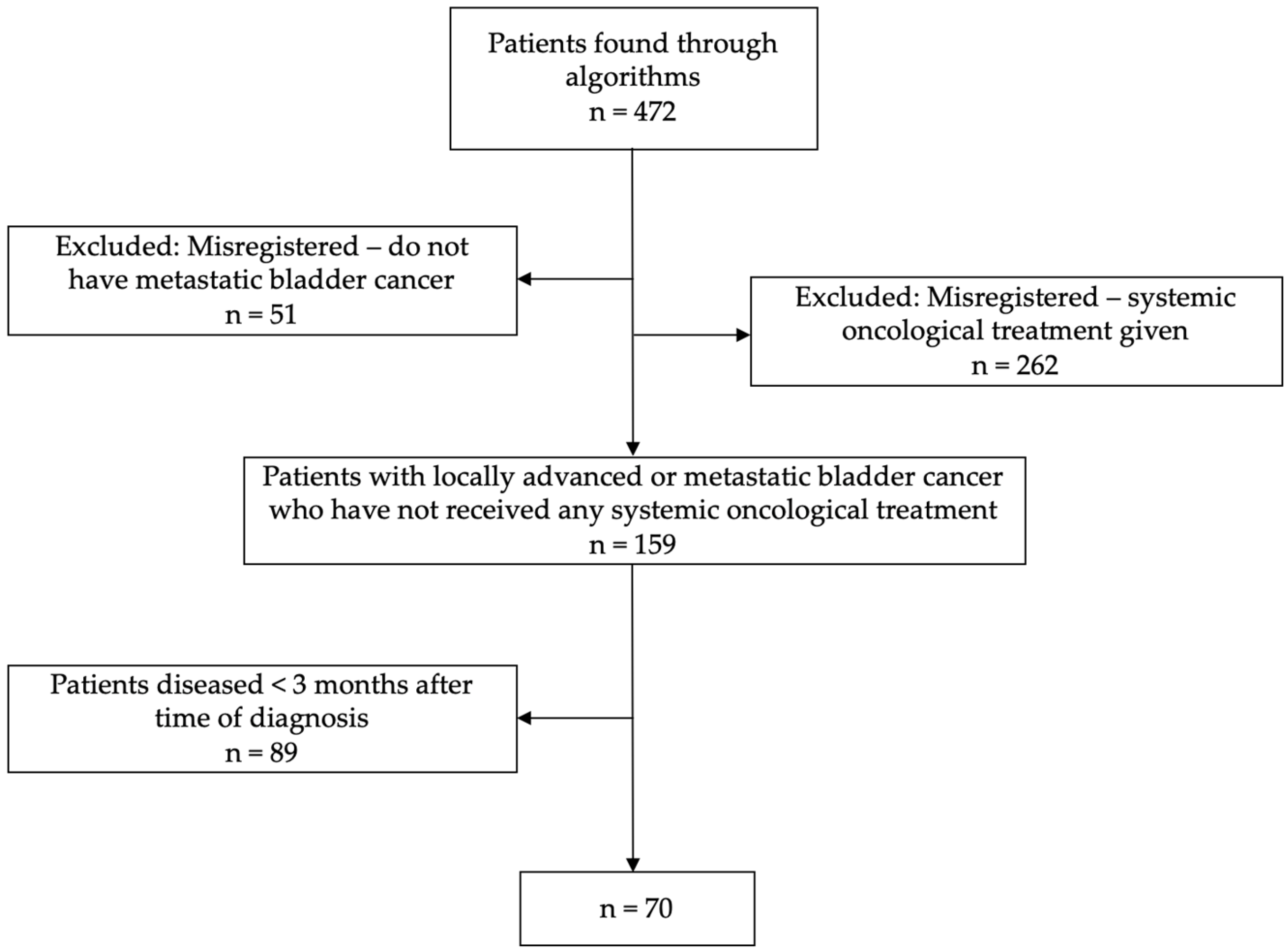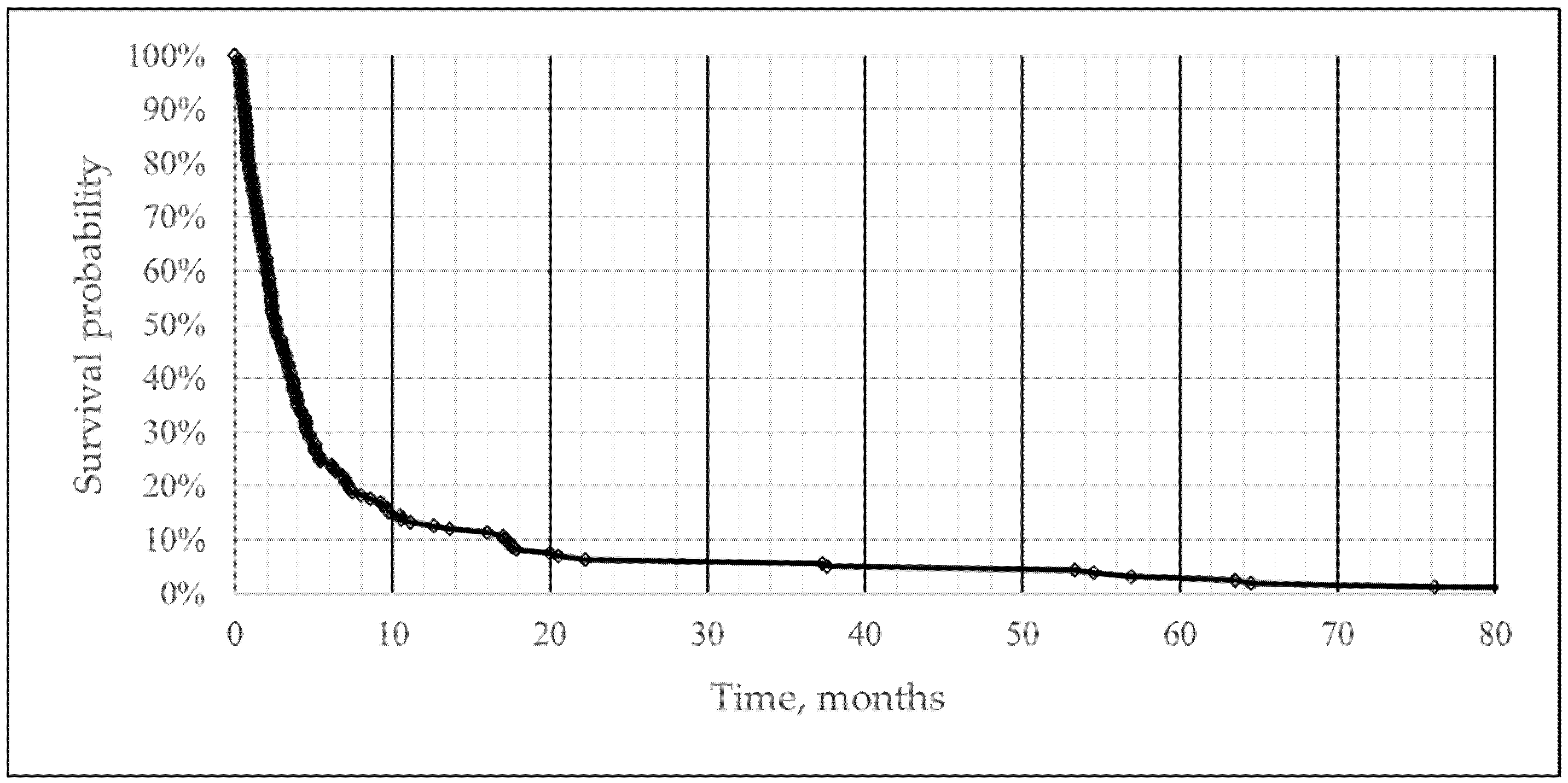Patients with Metastatic or Locally Advanced Bladder Cancer Not Undergoing Systemic Oncological Treatment—Characteristics and Long-Term Outcome in a Single-Center Danish Cohort
Simple Summary
Abstract
1. Introduction
2. Materials and Methods
2.1. Data Sources and Study Population
2.2. Outcome and Statistical Analysis
3. Results
4. Discussion
5. Conclusions
Author Contributions
Funding
Institutional Review Board Statement
Informed Consent Statement
Data Availability Statement
Conflicts of Interest
References
- Richters, A.; Aben, K.K.H.; Kiemeney, L.A.L.M. The global burden of urinary bladder cancer: An update. World J. Urol. 2020, 38, 1895–1904. [Google Scholar]
- Powles, T.; Bellmunt, J.; Comperat, E.; De Santis, M.; Huddart, R.; Loriot, Y.; Necchi, A.; Valderrama, B.P.; Ravaud, A.; Shariat, S.F.; et al. Bladder cancer: ESMO Clinical Practice Guideline for diagnosis, treatment and follow-up. Ann. Oncol. 2022, 33, 244–258. [Google Scholar] [PubMed]
- The Danish Bladder Cancer Group (DaBlaCa). Annual Report 2022. 2023. Available online: https://www.sundk.dk/media/bwaet3cf/a79647f3268f4da6bcce76d14a127b8d.pdf (accessed on 30 November 2023). (In Danish).
- Robert, S.; Svatek, A.S.-R.; Colin, P.; Dinney, M.D. Management of metastatic urothelial cancer: The role of surgery as an adjunct to chemotherapy. Can. Urol. Assoc. J. 2009, 3, 228–231. [Google Scholar]
- Stecca, C.; Abdeljalil, O.; Sridhar, S.S. Metastatic Urothelial Cancer: A Rapidly Changing Treatment Landscape. Ther. Adv. Med. Oncol. 2021, 13, 17588359211047352. [Google Scholar] [PubMed]
- Patel, V.G.; Oh, W.K.; Galsky, M.D. Treatment of muscle-invasive and advanced bladder cancer in 2020. CA Cancer J. Clin. 2020, 70, 404–423. [Google Scholar]
- Witjes, J.A.; Bruins, H.M.; Cathomas, R.; Comperat, E.M.; Cowan, N.C.; Gakis, G.; Hernandez, V.; Linares Espinos, E.; Lorch, A.; Neuzillet, Y.; et al. European Association of Urology Guidelines on Muscle-Invasive and Metastatic Bladder Cancer: Summary of the 2020 Guidelines. Eur. Urol. 2021, 79, 82–104. [Google Scholar]
- Sengeløv, L.; Kamby, C.; von der Maase, H. Pattern of metastases in relation to characteristics of primary tumor and treatment in patients with disseminated urothelial carcinoma. J. Urol. 1996, 155, 111–114. [Google Scholar]
- The Danish Bladder Cancer Group (DaBlaCa). Clinical Guidelines for T4b and Metastatic Bladder Cancer. 2022. Available online: https://www.dmcg.dk/kliniske-retningslinjer/kliniske-retningslinjer-opdelt-paa-dmcg/cancer-i-urinvejene/blaerekraeft/ (accessed on 30 November 2023). (In Danish).
- Galsky, M.D.; Pal, S.K.; Lin, S.W.; Ogale, S.; Zivkovic, M.; Simpson, J.; Derleth, C.; Schiff, C.; Sonpavde, G. Real-World Effectiveness of Chemotherapy in Elderly Patients with Metastatic Bladder Cancer in the United States. Bladder Cancer 2018, 4, 227–238. [Google Scholar]
- Sonpavde, G.; Galsky, M.D.; Latini, D.; Chen, G.J. Cisplatin-ineligible and chemotherapy-ineligible patients should be the focus of new drug development in patients with advanced bladder cancer. Clin. Genitourin. Cancer 2014, 12, 71–73. [Google Scholar] [CrossRef]
- Porter, M.P.; Kerrigan, M.C.; Donato, B.M.; Ramsey, S.D. Patterns of use of systemic chemotherapy for Medicare beneficiaries with urothelial bladder cancer. Urol. Oncol. 2011, 29, 252–258. [Google Scholar] [CrossRef]
- Balar, A.V.; Castellano, D.; O’Donnell, P.H.; Grivas, P.; Vuky, J.; Powles, T.; Plimack, E.R.; Hahn, N.M.; de Wit, R.; Pang, L.; et al. First-line pembrolizumab in cisplatin-ineligible patients with locally advanced and unresectable or metastatic urothelial cancer (KEYNOTE-052): A multicentre, single-arm, phase 2 study. Lancet Oncol. 2017, 18, 1483–1492. [Google Scholar] [PubMed]
- Small, A.C.; Tsao, C.K.; Moshier, E.L.; Gartrell, B.A.; Wisnivesky, J.P.; Godbold, J.H.; Smith, C.B.; Sonpavde, G.; Oh, W.K.; Galsky, M.D. Prevalence and characteristics of patients with metastatic cancer who receive no anticancer therapy. Cancer 2012, 118, 5947–5954. [Google Scholar] [PubMed]
- Omland, L.H.; Joensen, U.N.; Toft, B.G.; Lund, C.M.; Lindberg, H.; Knudsen, M.B.; Tolver, A.; Suetta, C.; Pappot, H. Reasons for lack of treatment in patients with locally advanced, unresectable or metastatic urothelial carcinoma. Acta Oncol. 2022, 61, 1036–1042. [Google Scholar] [PubMed]
- Norgaard, M.; Mailhac, A.; Fagerlund, K.; Strunz-McKendry, T.; Agerbaek, M.; Jensen, J.B. Treatment patterns, survival, and healthcare utilisation and costs in patients with locally advanced and metastatic bladder cancer in Denmark 2015–2020. Acta Oncol. 2023, 62, 1784–1790. [Google Scholar]
- Galsky, M.D.; Hahn, N.M.; Rosenberg, J.; Sonpavde, G.; Hutson, T.; Oh, W.K.; Dreicer, R.; Vogelzang, N.; Sternberg, C.N.; Bajorin, D.F.; et al. Treatment of patients with metastatic urothelial cancer “unfit” for Cisplatin-based chemotherapy. J. Clin. Oncol. 2011, 29, 2432–2438. [Google Scholar] [CrossRef]
- Bellmunt, J.; Choueiri, T.K.; Fougeray, R.; Schutz, F.A.; Salhi, Y.; Winquist, E.; Culine, S.; von der Maase, H.; Vaughn, D.J.; Rosenberg, J.E. Prognostic factors in patients with advanced transitional cell carcinoma of the urothelial tract experiencing treatment failure with platinum-containing regimens. J. Clin. Oncol. 2010, 28, 1850–1855. [Google Scholar]
- Omland, L.H.; Lindberg, H.; Carus, A.; Als, A.B.; Jensen, N.V.; Taarnhoj, G.A.; Trepiakas, R.; Suetta, C.; Omland, L.H.; Pappot, H. Real-World Treatment Patterns and Overall Survival in Locally Advanced and Metastatic Urothelial Tract Cancer Patients Treated with Chemotherapy in Denmark in the Preimmunotherapy Era: A Nationwide, Population-Based Study. Eur. Urol. Open Sci. 2021, 24, 1–8. [Google Scholar]
- Bellmunt, J.; Mottet, N.; De Santis, M. Urothelial carcinoma management in elderly or unfit patients. Eur. J. Cancer Suppl. 2016, 14, 1–20. [Google Scholar]
- Stensland, K.D.; Galsky, M.D. Current Approaches to the Management of Bladder Cancer in Older Patients. Am. Soc. Clin. Oncol. Educ. Book 2014, 34, e250–e256. [Google Scholar]
- Nadal, R.; Bellmunt, J. Management of metastatic bladder cancer. Cancer Treat. Rev. 2019, 76, 10–21. [Google Scholar]
- Fisher, M.D.; Shenolikar, R.; Miller, P.J.; Fenton, M.; Walker, M.S. Treatment Patterns and Outcomes in Stage IV Bladder Cancer in a Community Oncology Setting: 2008–2015. Clin. Genitourin. Cancer 2018, 16, 1171–1179. [Google Scholar]
- Bajorin, D.F.; Dodd, P.M.; Mazumdar, M.; Fazzari, M.; McCaffrey, J.A.; Scher, H.I.; Herr, H.; Higgins, G.; Boyle, M.G. Long-term survival in metastatic transitional-cell carcinoma and prognostic factors predicting outcome of therapy. J. Clin. Oncol. 1999, 17, 3173–3181. [Google Scholar] [CrossRef] [PubMed]
- von der Maase, H.; Sengelov, L.; Roberts, J.T.; Ricci, S.; Dogliotti, L.; Oliver, T.; Moore, M.J.; Zimmermann, A.; Arning, M. Long-term survival results of a randomized trial comparing gemcitabine plus cisplatin, with methotrexate, vinblastine, doxorubicin, plus cisplatin in patients with bladder cancer. J. Clin. Oncol. 2005, 23, 4602–4608. [Google Scholar] [PubMed]
- Schmidt, M.; Schmidt, S.A.J.; Adelborg, K.; Sundboll, J.; Laugesen, K.; Ehrenstein, V.; Sorensen, H.T. The Danish health care system and epidemiological research: From health care contacts to database records. J. Clin. Epidemiol. 2019, 11, 563–591. [Google Scholar]


| Type of Code | Codes | Definition | n (%) |
|---|---|---|---|
| X-diagnosis code | DC679X | Bladder cancer | 41 (9) |
| M-diagnosis code | DC679M | Bladder cancer | 96 (20) |
| Other diagnosis code | DC77, DC78, DC79 | Metastasis to the lymphatic system or distant metastasis | 239 (51) |
| SNOMED code | ÆF4530, M8***6, M8***7 | Metastasis or recurrence | 96 (20) |
| Reason | n (%) |
|---|---|
| Poor general condition | 118 (74.2) |
| Patient’s own wish | 31 (19.5) |
| Poor renal function | 19 (11.9) |
| Age | 15 (9.4) |
| Metastasis locally treated (radiotherapy/surgery) | 6 (3.8) |
| Comorbidity | 5 (3.1) |
| Do not tolerate treatment | 2 (1.3) |
| Dialysis | 1 (0.6) |
| Metastasis diagnosed at autopsy | 1 (0.6) |
| Characteristics | Unit |
|---|---|
| Median age at diagnosis, years (IQR) | 78 (73–83) |
| Gender, n (%) | |
| Male | 46 (65.7) |
| Female | 24 (34.3) |
| ASA physical status at diagnosis, n (%) | |
| 1 | 3 (4.3) |
| 2 | 30 (42.9) |
| 3 | 36 (51.4) |
| 4 | 1 (1.4) |
| Median BMI at diagnosis, kg/m2 (IQR) | 24.9 (23.1–28.12) |
| Median creatinine level at diagnosis, μmol/L (IQR) | 111 (83;136) |
| Comorbidity, n (%) | |
| Diabetes mellitus without complications | 15 (28.8) |
| Chronic lung disease | 15 (28.8) |
| Myocardial infarction | 12 (23.1) |
| Pulmonary embolism | 8 (15.4) |
| Renal disease (moderate/severe) | 8 (15.4) |
| Peripheral vascular disease | 8 (15.4) |
| Cerebrovascular disease | 8 (15.4) |
| Other cancer disease, non-metastatic | 7 (13.5) |
| Other cancer disease, metastatic | 4 (7.7) |
| Dementia | 3 (5.8) |
| Liver disease | 2 (3.8) |
| Diabetes mellitus with complications | 2 (3.8) |
| Connective tissue disease | 1 (1.9) |
| Gastric ulcer | 1 (1.9) |
| Hemiplegia | 1 (1.9) |
| Chronic heart disease (EF < 40%) | 1 (1.9) |
| Lymphoma | 1 (1.9) |
| TNM stage of metastatic disease, n (%) | |
| Any T, N+, M0 | 14 (20) |
| Any T, Any N, M1 | 55 (78.6) |
| Metastasis sites, n (%) | |
| Lymph nodes | 38 (54.3) |
| Lungs | 20 (28.6) |
| Bone | 18 (25.7) |
| Liver | 14 (20.0) |
| Soft tissue | 8 (11.4) |
| Other | 8 (11.4) |
| CNS | 4 (5.7) |
| Local recurrence | 3 (4.3) |
| Carcinomatosis | 2 (2.9) |
| Initial presentation of urothelial disease, n (%) | |
| Metastatic or locally advanced bladder cancer | 20 (28.6) |
| Local bladder cancer | 50 (71.4) |
| Data | Unit |
|---|---|
| Median time from primary local urothelial disease to metastatic disease, days (IQR) | 340 (201; 828) |
| Prior urothelial disease, TNM stage, n (%) | |
| Ta | 4 (8.0) |
| T1 | 3 (6.0) |
| T2 | 17 (34.0) |
| T3 | 21 (42.0) |
| T4a | 5 (10.0) |
| N0 | 36 (72.0) |
| N1 | 13 (26.0) |
| Nx | 1 (2.0) |
| M0 | 47 (94.0) |
| M1 | 3 (6.0) |
| Prior urothelial disease, treatment, n (%) | |
| Radical Cystectomy | 31 (62.0) |
| Non-radical cystectomy | 5 (10.0) |
| Curative radiotherapy | 8 (16.0) |
| TURBT, intravesical therapy | 5 (10.0) |
| No treatment | 1 (2.0) |
| Prior urothelial disease, neoadjuvant chemotherapy, n (%) | 7 (14.0) |
| Metastatic pattern for prior treated patients, n (%) | |
| Lymph nodes | 37 (74.0) |
| Lungs | 20 (40.0) |
| Bones | 18 (36.0) |
| Liver | 14 (28.0) |
| Soft tissue | 8 (16.0) |
| Other | 6 (12.0) |
| CNS | 4 (8.0) |
| Local recurrence | 3 (6.0) |
| Carcinomatosis | 2 (4.0) |
Disclaimer/Publisher’s Note: The statements, opinions and data contained in all publications are solely those of the individual author(s) and contributor(s) and not of MDPI and/or the editor(s). MDPI and/or the editor(s) disclaim responsibility for any injury to people or property resulting from any ideas, methods, instructions or products referred to in the content. |
© 2025 by the authors. Licensee MDPI, Basel, Switzerland. This article is an open access article distributed under the terms and conditions of the Creative Commons Attribution (CC BY) license (https://creativecommons.org/licenses/by/4.0/).
Share and Cite
Thorsteinsson, K.; Brandt, S.B.; Jensen, J.B. Patients with Metastatic or Locally Advanced Bladder Cancer Not Undergoing Systemic Oncological Treatment—Characteristics and Long-Term Outcome in a Single-Center Danish Cohort. Cancers 2025, 17, 1105. https://doi.org/10.3390/cancers17071105
Thorsteinsson K, Brandt SB, Jensen JB. Patients with Metastatic or Locally Advanced Bladder Cancer Not Undergoing Systemic Oncological Treatment—Characteristics and Long-Term Outcome in a Single-Center Danish Cohort. Cancers. 2025; 17(7):1105. https://doi.org/10.3390/cancers17071105
Chicago/Turabian StyleThorsteinsson, Kira, Simone Buchardt Brandt, and Jørgen Bjerggaard Jensen. 2025. "Patients with Metastatic or Locally Advanced Bladder Cancer Not Undergoing Systemic Oncological Treatment—Characteristics and Long-Term Outcome in a Single-Center Danish Cohort" Cancers 17, no. 7: 1105. https://doi.org/10.3390/cancers17071105
APA StyleThorsteinsson, K., Brandt, S. B., & Jensen, J. B. (2025). Patients with Metastatic or Locally Advanced Bladder Cancer Not Undergoing Systemic Oncological Treatment—Characteristics and Long-Term Outcome in a Single-Center Danish Cohort. Cancers, 17(7), 1105. https://doi.org/10.3390/cancers17071105








